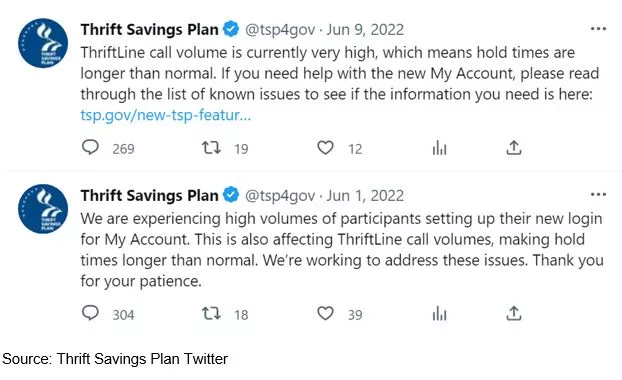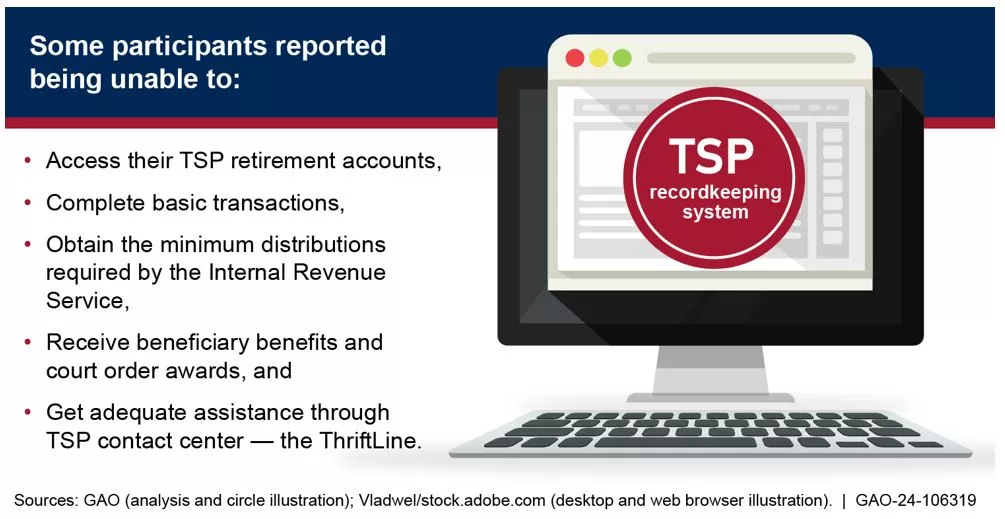What Went Wrong with the Launch of Thrift Savings Plan’s New Online System?
Just over two years ago, the Thrift Savings Plan launched a new online system meant to modernize and improve users’ access to their federal retirement savings. But almost immediately after the system launched, users reported widespread problems accessing their retirement savings and account information. By the end of that first day, TSP’s hotline had received 120,644 calls—with many users waiting hours to get help with accessing their accounts.
Here, at GAO, we received pleas for help from some users, many of whom told us that they were unable to access funds to pay bills or time sensitive information needed to get loans and mortgages.
Congress heard the complaints too and asked that GAO look into what caused the widespread problems and what is being done to prevent future issues. Today’s WatchBlog post looks at our new report on what we found.
Image

Why was the TSP system updated?
TSP is the largest retirement savings program with about $895 billion in assets and 7 million participants and beneficiaries. It’s a key component of federal employees’ retirement savings.
The prior online system used to manage the TSP was outdated and couldn’t take advantage of more modernized technology, such as a mobile application. So, in 2022, Federal Retirement Thrift Investment Board (FRTIB) launched a modernized system with more options for participants.
Some of the updates that were intended to improve users’ experience included:
- 24/7 self-service access to transactions and information
- A mobile app for users to access on their smart phones
- A streamlined (more user-friendly) interface
Updates were also geared toward helping TSP administrators. Prior to the launch of the new online system, FRTIB, which manages TSP, was also managing and operating the IT used for recordkeeping, call centers, and more. IT updates shifted these responsibilities to contractors with more modern systems.
What went wrong with TSP’s new system launch?
Soon after the new system launched, TSP participants experienced a variety of issues with managing their account and completing transactions. These issues included the initial set up of the account, missing beneficiary data, completing rollover requests, and receiving required minimum distributions, among other things. Participants also reported difficulty in getting adequate assistance from the ThriftLine, TSP’s customer service line.
Image

FRTIB and its contractor have taken a number of steps to identify the root of these problems and make necessary changes to the system to prevent future issues. Since taking these steps, participant satisfaction with the system has steadily improved in the wake of its launch.
What is FRTIB doing to prevent future issues?
FRTIB regularly oversees its contractor’s performance in operating and maintaining the recordkeeping system. The contractor can earn credits or receive penalties depending on how well it meets established performance targets. But FRTIB was challenged in some areas to oversee its contractor’s performance because it didn’t have the right data available.
FRTIB could do more to avoid future issues. We recommended, among other things, that it develop a process to ensure that future updates and acquisitions include improved processes for monitoring its contractor’s performance. This would allow FRTIB to ensure both its and users’ needs are met.
Learn more about our work and recommendations on this issue by reading our new report.
- GAO’s fact-based, nonpartisan information helps Congress and federal agencies improve government. The WatchBlog lets us contextualize GAO’s work a little more for the public. Check out more of our posts at GAO.gov/blog.
- Got a question? Email us at blog@gao.gov.
GAO Contacts
Related Products

GAO's mission is to provide Congress with fact-based, nonpartisan information that can help improve federal government performance and ensure accountability for the benefit of the American people. GAO launched its WatchBlog in January, 2014, as part of its continuing effort to reach its audiences—Congress and the American people—where they are currently looking for information.
The blog format allows GAO to provide a little more context about its work than it can offer on its other social media platforms. Posts will tie GAO work to current events and the news; show how GAO’s work is affecting agencies or legislation; highlight reports, testimonies, and issue areas where GAO does work; and provide information about GAO itself, among other things.
Please send any feedback on GAO's WatchBlog to blog@gao.gov.




